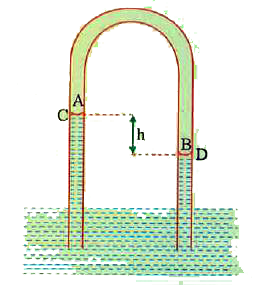A glass U-tube is such that the diameter of one limb is 3.0mm and that of the other is 6.0mm. The tube is inverted vertically with the open ends below the surface of water in a beaker. What is the difference between the height to which water rises in the two limbs? Surface tension of water is 0.07Nm−1. Assume that the angle of contact between water and glass is 0∘.
Let PAandPB are the pressure at points A and B respectively. The pressure at poin C.
PC=PA−2TR1, Where R1=r1cos0∘=r1
The pressure at point D,PD=PB−2TR2
Where, R2=r2cos0∘=r2

If .h. is the difference in levels of liquid in two limbs, then
PD−PC=hρg⇒(PB−2TR2)−(PA−2TR1)=hρg
As PA=PBandR1=r1=1.5mm,
R2=r2=0.3mm, so 2T(1r1−1r2)=hρg
0.2×0.07(11.5×10−3−13×10−3)=h×1000×9.8
After solving, we get h=4.7×10−3,m
Topper's Solved these Questions
- MECHANICAL PROPERTIES OF FLUIDSBook:NARAYNAChapter:MECHANICAL PROPERTIES OF FLUIDSExercise:EVALUATE YOURSELF - 1
Explore 2 Videos
- MECHANICAL PROPERTIES OF FLUIDSBook:NARAYNAChapter:MECHANICAL PROPERTIES OF FLUIDSExercise:EVALUATE YOURSELF - 2
Explore 2 Videos
- MECHANICAL PROPERTIES OF FLUIDSBook:NARAYNAChapter:MECHANICAL PROPERTIES OF FLUIDSExercise:Level 2 (H.W)
Explore 39 Videos
- MATHEMATICAL REVIEW & PHYSICAL WORLDBook:NARAYNAChapter:MATHEMATICAL REVIEW & PHYSICAL WORLDExercise:C.U.Q
Explore 13 Videos
- MECHANICAL PROPERTIES OF SOLIDSBook:NARAYNAChapter:MECHANICAL PROPERTIES OF SOLIDSExercise:LEVEL-II (H.W)
Explore 24 Videos
Similar Questions
A U-tube is made of capillaries of bore 2 mm and 4mm, respectively. The tube is held vertically inverted with the open ends below the surface liquid in a beaker. Calculate the difference in the levels of the meniscus in the two limbs. Take.
Surface tension of liquid =48 dyne/cm density =0.8gcm−3
Angle of contact between liquid and glass =0∘
g=980cm/s2.
View SolutionFind the weight of water supported by surface tension in a capillary tube with a radius of 0.2 mm. Surface tension of water is 0.072Mn−1 and angle of contact of water is 00.
View Solution
Knowledge Check
A capillary tube of 2mm diameter. What is the height to which water rises, if surface tension of water is 7.4×10−9Nm−1 and angle of contact is 0∘ ?
A0.25mmB1.51mmC0.4mmD0.5mmIf the surface tension of water is 0.06 Nm−1, then then the capillary rise in a tube of diameter 1 mm is (θ=0∘)
A3.86 cmB3.12 cmC2.44 cmD1.22 cmSurface tension of water is 0.072 Nm−1. The excess pressure inside a water drop of diameter 1.2 mm is :-
A240 PaB120 PaC0.06 PaD60 Pa
A capillary tube of radius 0.50 mm is dipped vertically in a pot of water. Find the difference between the pressure of the water in the tube 5.0 cm below the surface and the atmospheric pressure. Surface tension of water =0.075Nm−1
View SolutionA U-tube is supported with its limbs vertical and is partly filled with water. If the internal diameters of the limbs are 1×10−2mand1×10−4m respectively. What will be the difference in heights of water in the two limbs? (Surface tension of water is 0.07 N/m.)
View SolutionCalculate the difference h in water levels in two commnicating capillary tube of radius 1mm and 1.5mm. Surface tension of water=0.07Nm−1

View SolutionA capillary tube of radius 0.5 mm is dipped in a vessel containing water. Calculate the height to which water will rise in the capillary tube. Take, surface tension of water =7.4×10−3 N/m.
View SolutionIf the surface tension of water is 0.06 Nm, then the capillary rise in a tube of diameter 1mm is (θ=0∘)
View Solution